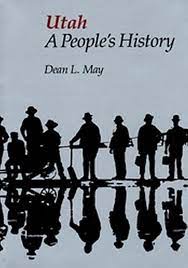Articles/Essays – Volume 22, No. 1
History for the People | Dean L. May, Utah: A People’s History
Dean L. May has tackled a difficult problem in this brief survey of Utah’s history. First of all, his book came after the successful media presentation of the same material instead of vice versa, as is usually the case. Second, Professor May is a professional historian who, by training and, presumably, inclination, commonly writes for a like-minded audience. And, finally, Utah: A People’s History has been preceded by several other solid treatments of the same subject. Nevertheless, this book does accomplish its purpose — to provide a companion volume to KUED television’s Utah history series (p. x).
May’s beginning chapter, aptly entitled “Man and Desert,” provides a strong introduction to the book by immediately calling our attention to the fact that surviving in Utah has not always involved cozy homes, mundane commutes to one’s workplace, air-conditioned summers, and centrally-heated winters. Utah was, and in many ways still is, a harsh land. As the forty-niners, who passed as quickly as possible through the area on their way to the riches of California, observed, Utah was a distinct land marked by vast deserts and a huge saltwater lake. Even for the Mormon immigrants of 1847 and later, the Great Salt Lake Valley — not to mention areas more distant and isolated settled later—must certainly have been a disheartening reminder of the fertile soil and abundant water left behind in the Midwest. It clearly took a dispossessed and/or a committed people to live in the Great Basin.
Chapters two and three, almost Turnerian in interpretation, discuss the impact of the fur trappers and then the Anglo American farmers, merchants, and community builders who succeeded the Jedediah Smiths and Peter Skene Ogdens across the Rocky Mountains in hopes of exploiting the natural resources and open land of the West. Chapter four discusses the Mormons, whose presence, the author notes, cannot be escaped in any study of Utah (pp. x-xi). On 22 July 1847, William Clayton accompanied the first sixty wagons of Mormon pioneers into the Great Salt Lake Valley. May notes Clayton’s first impression, “The land looks dry and lacks rain” (p. 65) — certainly one of history’s great understatements! But, as would his fellow Latter-day Saints, Clayton tried to remain upbeat by adding that the numerous creeks and springs in the location might be used to moisten the land somewhat. From that thought and commitment sprang present day Utah.
Dean May has rendered a more than adequate, popular treatment of Utah’s history. Some might criticize him for the ex tensive coverage he gives to Mormons throughout Utah: A People’s History, but a quick review of any recent Utah history, for example that of Charles S. Peterson, demonstrates what May notes from the outset: you cannot write about the Beehive State without writing about the Mormons. It would be like writing about Massachusetts and downplaying the Puritans.
The format of this book, written for a popular audience, has allowed May to make some useful asides that would have been out of place in a more “scholarly” monograph. For example, he advises his readers that, when visiting archaeological sites, “It is against the law and shamefully irresponsible to alter or remove . . . arti facts” (p. 19) —an ethical issue certainly important for Utahns as well as other Americans to understand.
Finally, the University of Utah Press should be congratulated for publishing what is truly “a people’s history” of Utah. This reasonably-priced, attractive book abounds in well-chosen and placed illustrations and maps and clearly fills a need in the Utah history book market. It is highly readable, factually sound, and interesting to the casual browser. In other words, in this book May has accomplished what he set out to do.
Utah: A People’s History by Dean L. May (Salt Lake City: University of Utah Press, 1987), 210 pp., illus., index, $25.00 cloth, $14.95 paper.


 Back to full Issue
Back to full Issue

